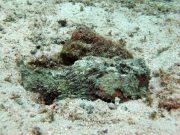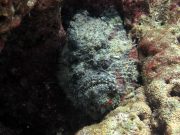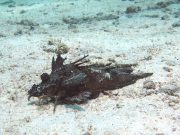Dykning med Stenfisk
Koh Lantas Marineliv | Synanceiidae
Stenfiskfamilien Synanceiidae er langsomme, bundlevende fisk, der lever i de lavvandede dele af revet blandt klipper og koraller. På vores dykkerture til Koh Lanta finder vi oftest stenfisk omkring lagunen ved Koh Haa.
Medlemmerne af denne familie er for det meste tykke fisk med store hoveder og munde og små øjne. Kroppen er dækket af ujævne vorteagtige hudkirtler og kødfulde flapper, der kan hjælpe med camouflagen. Nogle gange kan man se alger vokse på kroppen, hvilket forbedrer camouflagen yderligere.
Stenfisk findes normalt på bunden, begravet i sandet eller klamrende sig til et stykke dødt koral. De er mestre i camouflage og forklæder sig som klipper og sten, hvor de smelter næsten fuldstændigt sammen med omgivelserne i farve og form.



Ligesom deres slægtninge, skorpionfiskene, har stenfisk meget skarpe, hule rygfinner, der minder om en injektionsnål, og hver med en giftkirtel i bunden.
Stenfiskens gift bruges til selvforsvar, og giften sprøjtes normalt ud, når et intetanende offer ved et uheld læner sig mod eller træder på en af disse fisk. Den neurotoksiske gift er ekstremt smertefuld.
Den grålige, brunlige, rødlige revfisk (Synanceia verrucosa) er den mest giftige fisk, man kender til, og den findes på nogle af dykkerstederne omkring Koh Lanta, især i og omkring Koh Haa-lagunen. Revfiskens gift er dødelig for mennesker.
Den mørke Indian Ocean Walkman (Inimicus didactylus) findes også i og omkring Koh Haa Lagoon og er sværere at få øje på end Reef Stonefish. Den ligger normalt dybt begravet i sandet, men sjældent kan man se den, når den går langs havbunden for at skifte sted.
Walkmans i Det Indiske Ocean er også kendt under navnene ghoulfish, goblinfish, sea goblins, spiny devilfish, stinger og stingfish, og er ligeledes farligt giftige.
Vi opfordrer ikke folk til at sidde, knæle, gå eller hvile på de sarte havbunde omkring koralrevene, ikke kun på grund af de mange små og sarte dyr, der lever på havbunden, men også på grund af den meget reelle fare for at blive stukket af en af naturens mest giftige fisk.
Stenfisk er generelt ensomme og lever af små fisk og krebsdyr.
2 arter fundet på denne side:
Reef Stonefish
(Synanceia verrucosa)
The Reef Stonefish, Synanceia verrucosa, is one of 36 members of the Synanceiidae family and is one of the most venomous fish in the world. This fish has a large head and tapering body, with its mouth on top of the face, and a deep depression between its eyes.

Synanceia verrucosa @ Koh Haa
Typically the Reef Stonefish reaches lengths of up to 30 - 40 centimeters and is generally grey or brown in colour, though it may also have small areas of yellow, red or orange.
The key difference between males and females is the size. The female stonefish is larger and broader around the abdomen than the male and can weigh as much as 50% more.
A carnivorous fish, the Reef Stonefish may settle around rocks and plants, or rest on the seabed and is extremely well camouflaged as rock or coral. They are difficult to find and are also known to use their large pectoral fins to bury themselves in the sand, with only the eyes and mouth visible.
The Reef Stonefish eats mostly small fish, shrimp, and other crustaceans. It usually waits for its prey to swim past, and then strikes with incredible speed. Waiting for hours at a time, stonefish strike when their potential prey is less than their body length away. Their powerful jaws and large, rapidly expanding mouths create so much pressure that they are easily able to suck down their unsuspecting prey and swallow it whole. The attack can last as little as 0.01 seconds and requires high-speed video equipment to capture.

Reef Stonefish @ Koh Haa
As a purely defensive measure, the dorsal fin comprises 13 sharp, stiff, hollow spines, each with a venom sac. When disturbed, the Reef Stonefish will typically not swim away, and will instead erect it's poisonous dorsal fin spines.
The venom is usually released when pressure is applied to the stonefish's spine, which means the poison is most often emitted when the stonefish is being attacked by a predator or stepped on by a human. Effects of the venom include severe pain, shock, paralysis and tissue death. A large dose can be fatal to humans. Predators of the Reef Stonefish include sharks and rays.

Reef Stonefish @ Koh Haa
The stonefish can survive out of water for up to 24 hours. This may be an adaptation to its shallow water existence where it may get trapped in drying out rock-pools during low tide.
In addition to the dorsal spines and venom, stonefish also possess a 'lachrymal sabre', a very sharp spine embedded in each side of the face, beneath each eye. This sharp blade can be deployed by squeezing its cheeks, which pull on the upper jaw and rotate the spines. This built-in weapon is non-venomous, however, they are extremely sharp.
The stonefish is a solitary animal. The only time it will actively seek out another is during mating season. The female stonefish releases a layer of eggs on the seafloor, with the male then releasing sperm over them.
Indian Ocean Walkman
(Inimicus didactylus)
The Indian Ocean Walkman, also known as the Spiny Devilfish, has a flattened head, large bulbous eyes and an upturned shout. The dorsal spines are highly venomous, with the first three being connected by a thin membrane. Dorsal spines may cause very painful and deep wounds, and can be fatal.

Inimicus didactylus @ Koh Haa
The Indian Ocean Walkman can quickly change colour to aid camouflage, and likes to partially bury itself in sand during the day. The fan-like pectoral fins are very colourful when opened, usually when disturbed or during courtship.

Inimicus didactylus @ Koh Haa
This species can sometimes be seen 'walking' on the seafloor using the forward pelvic fin spines which are not connected via fin membrane, and have adapted as forward 'legs'.

Inimicus didactylus @ Koh Haa
The Indian Ocean Walkman grows to 25 cm and is found in sand and rubble areas close to coral reefs. The diet includes small fishes and crustaceans.
Dykning med Stenfisk omkring Koh Lanta
Dykning og snorkelture
Hvis du gerne vil have chancen for at se Stenfisk på en af vores daglige dykkerture i højsæsonen fra Koh Lanta, så send os en e-mail til info@diveandrelax.com.
Deltag i vores speedbådsdykkerture i højsæsonen til nogle af Thailands bedste dykkersteder og nyd små grupper, korte rejsetider med fokus på god personlig service, sikkerhed og sjov.
Er du endnu ikke certificeret dykker? Lær at dykke på Koh Lanta med det 3-dages SSI Open Water Diver-kursus.
Book online og spar 10% på dykkerture og dykkerkurser på Koh Lanta.
Få mere at vide
Indo-Stillehavets havdyrsguider
- Allen, G., Steene, R., Humann, P., DeLoach, N. (2003) Reef Fish Identification, Tropical Pacific. Jacksonville, FL., USA: New World Publications, Inc., ISBN 1-878348-36-1.
- Humann, P., DeLoach, N., (2010) Reef Creature Identification, Tropical Pacific. Jacksonville, FL., USA: New World Publications Inc., ISBN 978-1-878348-44-9
- Debelius, H. (2013) Indian Ocean Reef Guide. Frankfurt, Germany: IKAN - Unterwasserarchiv, ISBN 978-3-939767-52-7.
- Debelius, H. (2004) Nudibranchs and Sea Snails, Indo-Pacific Field Guide. Frankfurt, Germany: IKAN - Unterwasserarchiv, ISBN 3-925919-51-1
- Erhardt, H., Knop, D. (2015) Corals Indo-Pacific Field Guide. Frankfurt, Germany: IKAN - Unterwasserarchiv, ISBN 3-925919-69-4.
- Veron J.E.N., Stafford-Smith M.G., Turak E. and DeVantier L.M. (2016). Corals of the World
Flere referencer om havets dyreliv og yderligere information



